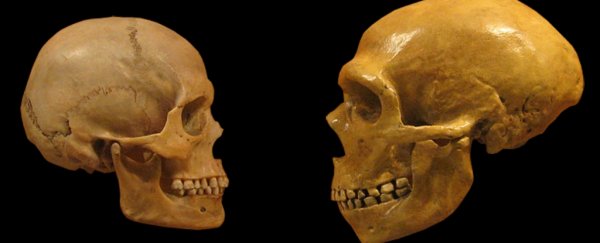Neanderthals have a reputation they do not deserve. Hunched over and hairy, these ancient hominins are often depicted as primitive and uncultured, resembling apes more than us.
But a mounting body of evidence suggests that, in reality, we share more similarities than differences. And one of the most famous features of Neanderthals is actually wrong.
After more than a century of alternative views, a new study has reconfirmed that Neanderthals once walked fully upright with a posture not unlike our own. They weren't hunched after all.
The reanalysis is based on an elderly male Neanderthal that was found in La Chapelle-aux-Saints, France in 1911. Creating a virtual reconstruction of the ancient skeleton's pelvis and spine, the authors say that both the stress on the hip and the position of the pelvis are not so different from modern humans.
When the research was extended to other Neanderthal skeletons, the vertebrae and pelvic bones also matched this model. Once thought to be a hallmark of modern humans, this suggests that the curve of your lower back is not so unique after all.
"On the whole, there is hardly any evidence that would point to Neanderthals having a fundamentally different anatomy," explains Martin Haeusler, a specialist in evolutionary medicine at the University of Zurich.
If Neanderthals really had a posture similar to humans, they would have needed a double s-shaped spine like our own. These curves exist to take on the majority of weight and shock that is conferred when walking.
But some recent studies using isolated vertebrae argued that Neanderthals actually had straighter spines than we thought – backing up the idea that Neanderthals were hunched.
The new research, however, suggests this conclusion is a mistake.
By examining the wear and tear of Neanderthal vertebrae from several different sources, the authors were able to reconstruct what they think was their true posture using computer simulations.
What they found was that the sacrum - the bone that stabilises the pelvis - is tilted in the same direction as in humans. This is the triangle-shaped bone that takes on all the upper body's weight, so its position can tell us a lot about how locomotion would have worked.
With the sacrum tilted inwards, as can be seen below, the authors conclude that Neanderthals must have had a well-developed curve in their lower back.

After also looking at vertebrae in the neck, the researchers found evidence that Neanderthals had a double s-shaped curve similar to humans, with one curve in the neck and the other in the lower back.
As evidence like this continues to grow, scientists are slowly coming to realise that there were less differences between the anatomy of humans and their ancient hominin cousins than we thought.
"Now is the time to recognise the basic similarities between Neanderthals and modern humans and to switch the focus to the subtle biological and behavioural changes that occurred in humans in the late Pleistocene," says Haeusler.
This study has been published in PNAS.
